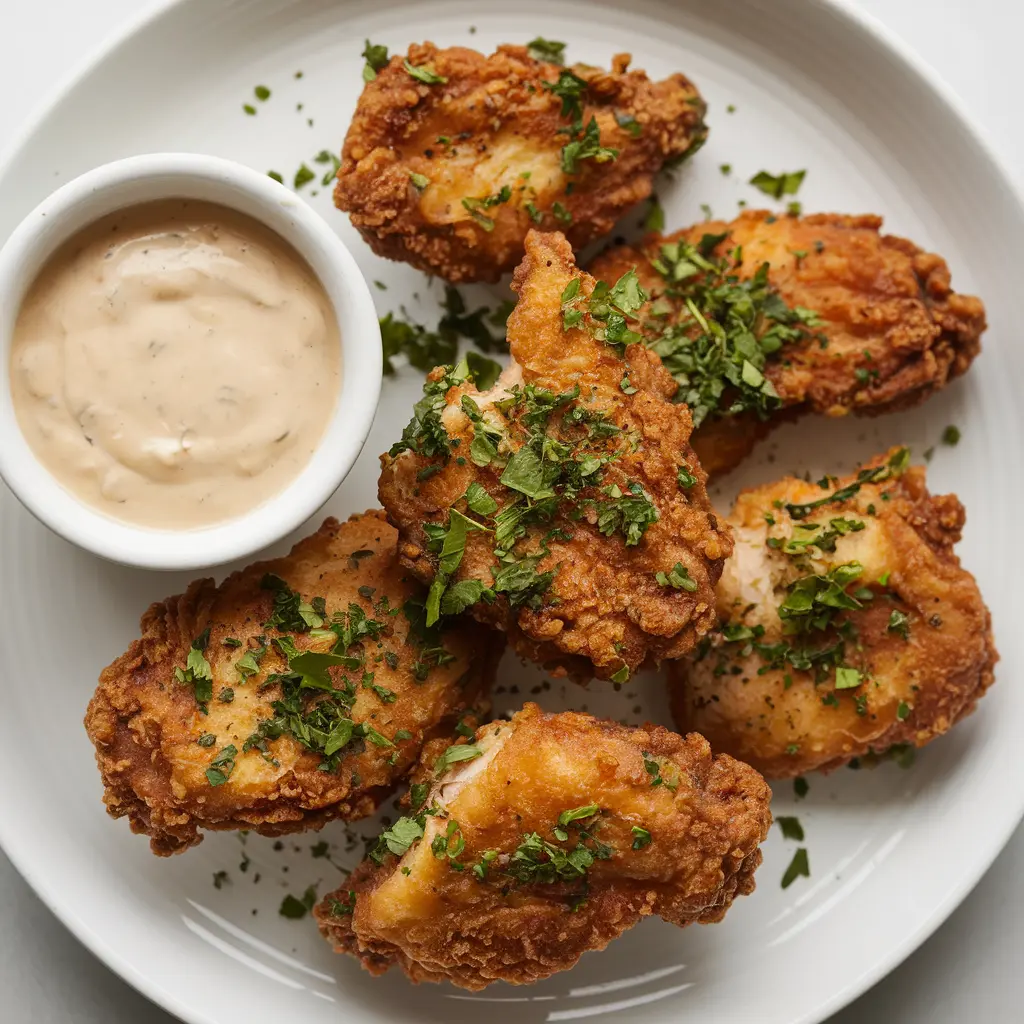Buttermilk chicken tenders are a crispy, golden-brown dish featuring strips of chicken marinated in buttermilk and coated in a flavorful breading before being fried or baked to perfection. This dish is beloved for its tender, juicy interior and crunchy exterior, making it a popular choice for family meals, gatherings, or as a savory snack
Table of contents
Essential Ingredients for Homemade Buttermilk Chicken Tenders
Essential Ingredients for Buttermilk Chicken Tenders
Crafting the perfect buttermilk chicken tenders starts with gathering high-quality ingredients. Here’s what you’ll need:
- Buttermilk Chicken Tenders or Breast Strips: These are the stars of the dish, known for their tenderness and versatility.
- Buttermilk: Key for marinating, it tenderizes the meat while adding a subtle tangy flavor.
- All-Purpose Flour: The base of the breading that creates the crispy outer layer.
- Cornstarch: Enhances the crispiness and makes the breading extra light.
- Seasonings: Paprika, garlic powder, onion powder, salt, and pepper are classic choices for flavoring.
- Eggs: Helps the breading stick to the chicken.
- Breadcrumbs or Panko: Adds crunch to the coating.
- Oil for Frying: Neutral oils like vegetable or canola work best for deep-frying.
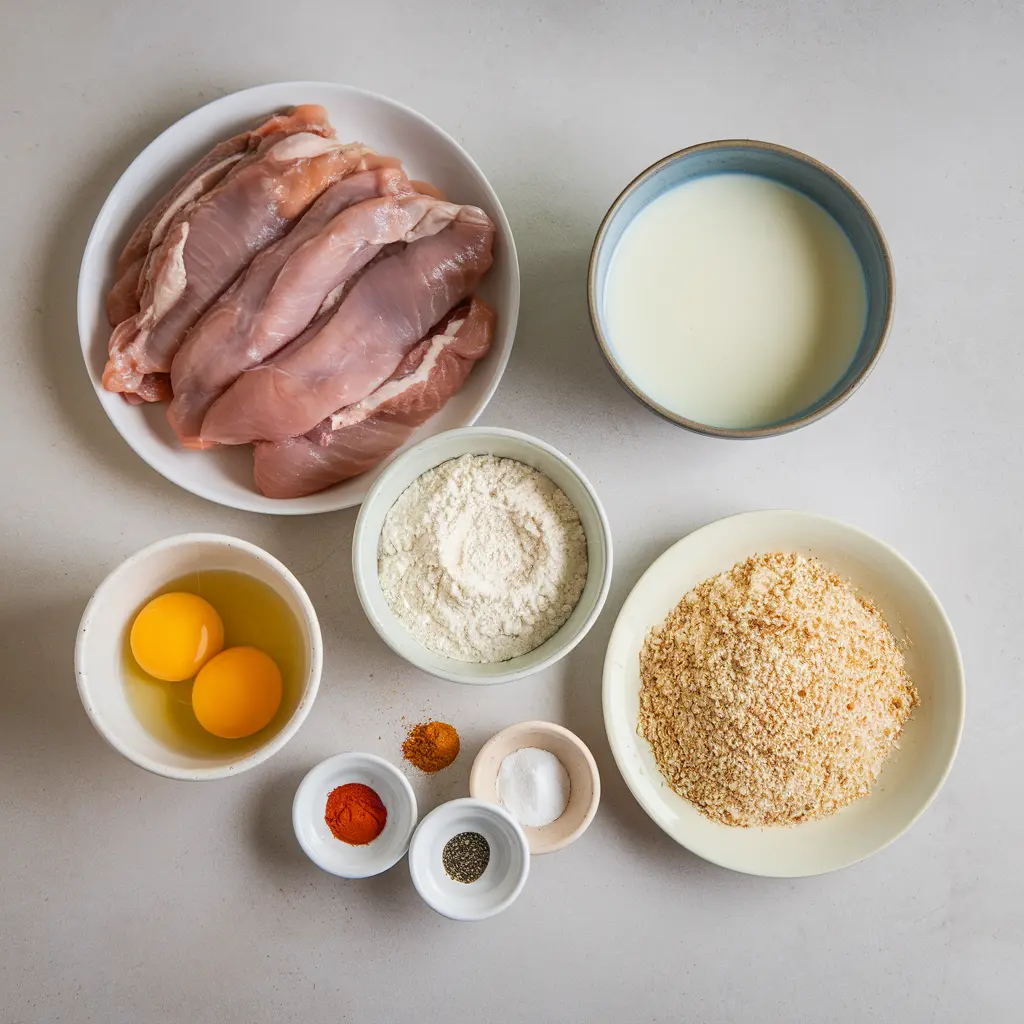
The Role of Each Ingredient in Enhancing Flavor
- Buttermilk: Its acidity not only tenderizes but also ensures a slightly tangy undertone that complements the savory breading.
- Flour and Cornstarch: These create a cohesive coating, with cornstarch amplifying crispiness.
- Seasonings: The combination of spices infuses the chicken with depth and richness. Adjust the blend to your taste for a personal touch.
- Eggs: These act as a glue, ensuring the coating stays intact during cooking.
- Breadcrumbs or Panko: Panko breadcrumbs, in particular, result in a lighter, crunchier texture than traditional breadcrumbs.
- Oil: A good frying oil ensures even cooking and a golden-brown finish without overpowering the flavor.
Optional Additions for Extra Zest
- Cayenne Pepper: For a kick of heat.
- Parmesan Cheese: Mix into the breading for added savory richness.
- Herbs: Dried thyme, oregano, or parsley can elevate the flavor.
- Hot Sauce: A splash in the buttermilk marinade introduces a spicy tang.
- Honey or Maple Syrup: Mix a little into the marinade for a sweet-and-savory twist.
Marinating the Chicken in Buttermilk for the Best Buttermilk Fried Chicken Tenders
Marinating the Buttermilk Chicken Tenders
- Prepare the Chicken: Start by cutting chicken breasts into strips if not using pre-cut tenders. Aim for uniform sizes to ensure even cooking.
- Create the Marinade: In a large bowl, combine buttermilk, a teaspoon of salt, a teaspoon of paprika, and optional hot sauce for extra flavor.
- Marinate the Chicken: Submerge the chicken strips in the buttermilk mixture, ensuring each piece is fully coated. Cover and refrigerate for at least 1 hour, though overnight is ideal for maximum tenderness and flavor infusion.
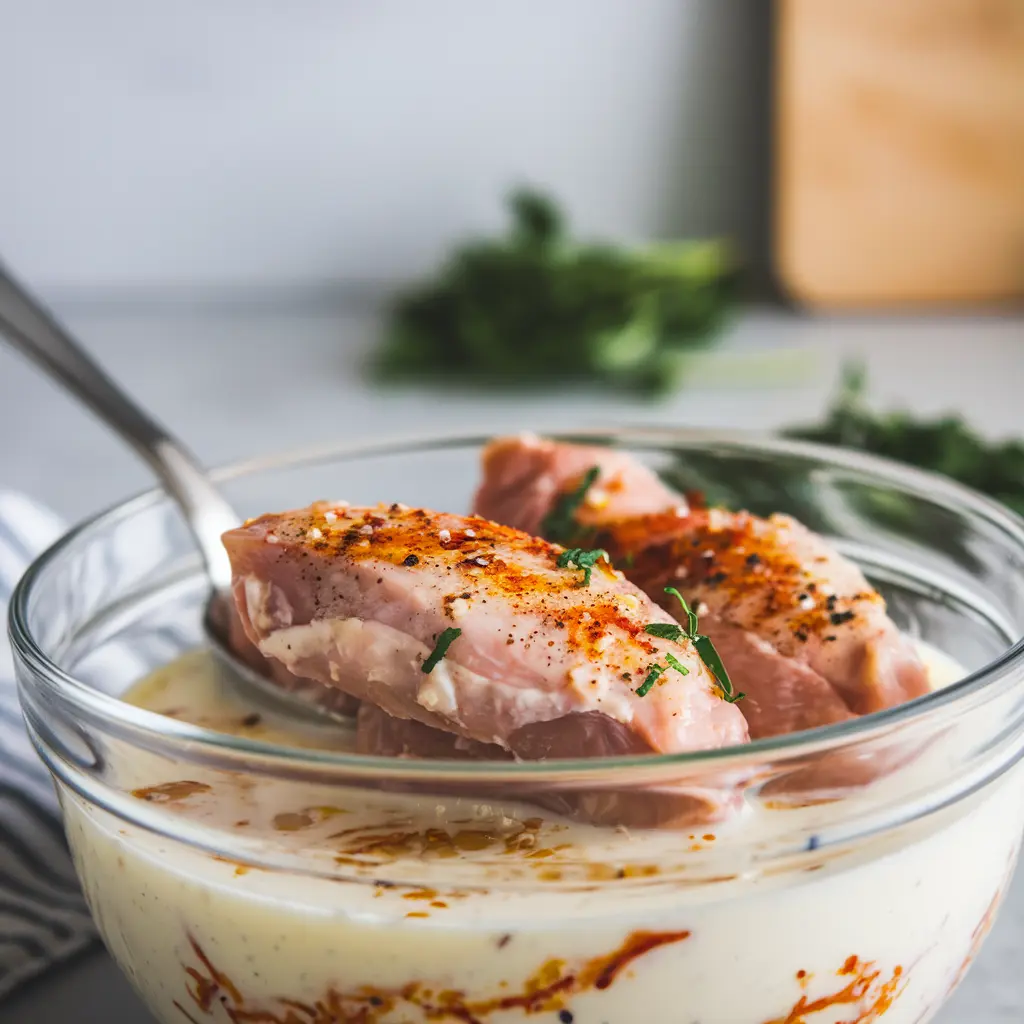
Preparing the Seasoned Coating
- Dry Mix: In a shallow dish, combine flour, cornstarch, breadcrumbs (or Panko), and your chosen seasonings such as garlic powder, onion powder, paprika, and black pepper. Stir well to evenly distribute the spices.
- Egg Wash: In another bowl, whisk eggs until fully beaten.
- Assembly Line Setup: Arrange your marinated chicken, egg wash, and seasoned flour mixture in a line for efficient breading.
Breading the Chicken
- Remove a piece of chicken from the marinade, letting excess buttermilk drip off.
- Dip the chicken into the flour mixture, pressing lightly to coat.
- Next, dip the floured chicken into the egg wash.
- Return it to the seasoned flour mix for a second coat, ensuring a thick, even layer. For extra crunch, press the chicken firmly into the coating.
Frying or Baking: Cooking Methods Explained
Frying:
- Heat 2-3 inches of oil in a heavy-bottomed pot or deep skillet to 350°F (175°C).
- Fry the coated Buttermilk chicken tenders in small batches, turning occasionally for even cooking. Each batch should take 6-8 minutes until golden brown and cooked through.
- Transfer to a wire rack or paper towel-lined plate to drain excess oil.
Baking:
- Preheat your oven to 400°F (200°C).
- Arrange the breaded Buttermilk chicken tenders on a greased or parchment-lined baking sheet. Lightly spray the tops with cooking spray for a crispier finish.
- Bake for 20-25 minutes, flipping halfway through, until golden brown and fully cooked.
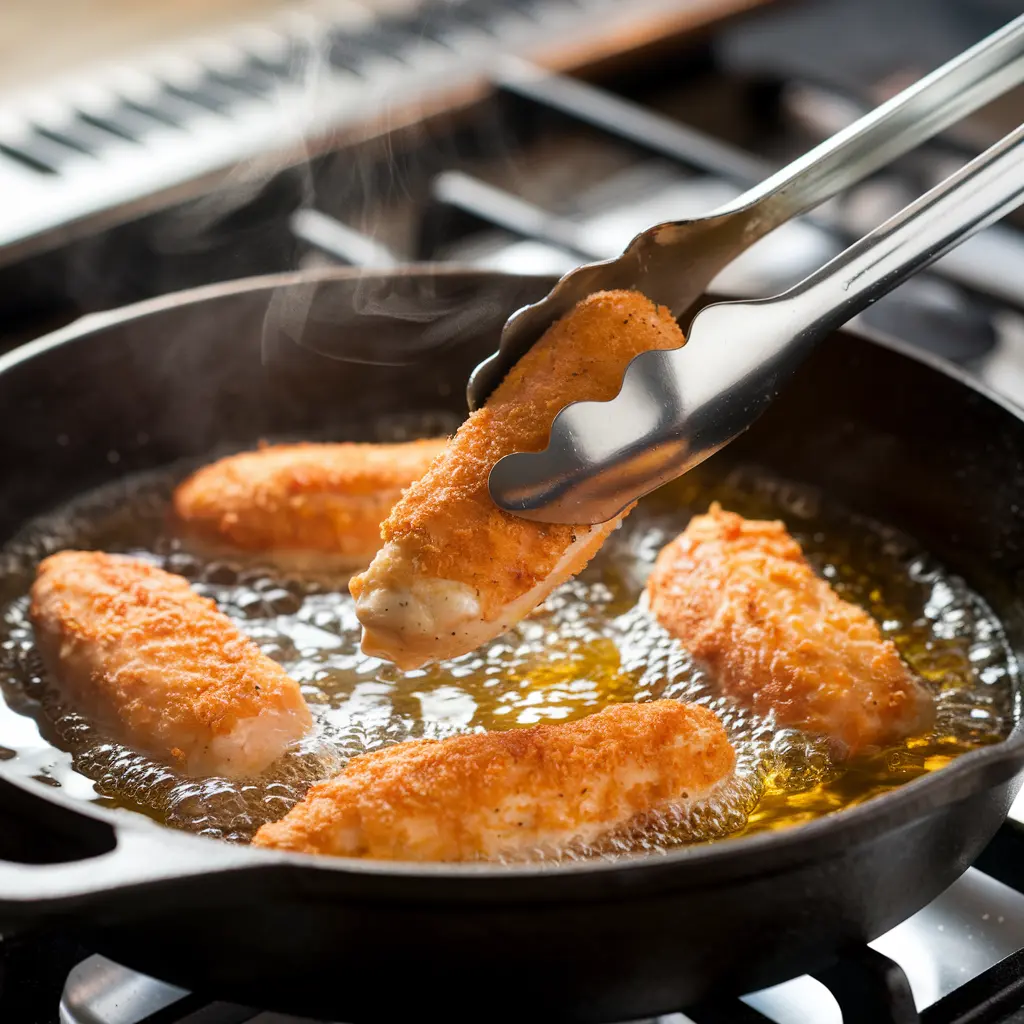
Air Frying Option:
For a healthier alternative, preheat your air fryer to 375°F (190°C). Cook the tenders in a single layer for 15-20 minutes, flipping halfway through. Spray lightly with oil to achieve a crispy exterior.
Tips for Perfect Buttermilk Chicken Tenders
Choosing the Best Chicken for Homemade Chicken Tenders
- Chicken Tenders: These are naturally tender and perfectly shaped for frying or baking, making them the ideal choice for this recipe.
- Chicken Breasts: If using chicken breasts, slice them into even strips to mimic the size of tenders. This ensures uniform cooking and prevents dry or uneven results.
- Avoid Frozen Cuts: Whenever possible, opt for fresh chicken to ensure optimal texture and flavor. If using frozen chicken, fully thaw and pat dry before marinating.
Ensuring the Crispiest Coating
- Double-Coating Method: After marinating, dip the chicken in the seasoned flour mixture, then into the egg wash, and back into the flour for a thicker, crunchier crust.
- Patting the Coating: Press the coating firmly onto the chicken to help it adhere better and form a more robust crust.
- Use Panko Breadcrumbs: Panko creates an airier, crisper texture compared to traditional breadcrumbs. Mixing Panko with flour gives you the best of both worlds.
Oil Temperature is Crucial
- Use a thermometer to maintain the oil temperature at 350°F (175°C). Oil that’s too hot will burn the coating before the chicken is cooked through, while oil that’s too cool will result in greasy tenders.
- Allow the oil to return to the correct temperature between batches to ensure consistent results.
Draining for Crispiness
- Once fried, place the tenders on a wire rack instead of paper towels. This prevents the tenders from sitting in excess oil, keeping the coating crisp and crunchy.
Avoiding Common Cooking Mistakes
- Overcrowding the Pan: Fry chicken in small batches to avoid lowering the oil temperature, which can lead to soggy coating.
- Skipping the Marination: The buttermilk soak is essential for tender, juicy chicken. Skipping this step can result in dry, less flavorful tenders.
- Under-Seasoning the Flour Mixture: Don’t be shy with your spices. A bland coating will result in unexciting tenders.
Pro Tip for Baking and Air Frying
- For oven or air fryer methods, lightly spray the tenders with oil before cooking. This encourages a golden, crispy finish without deep frying.
Serving Suggestions
Pairing with Dipping Sauces
No chicken tender experience is complete without a selection of flavorful dipping sauces. Here are some favorites to elevate your dish:
- Classic Ranch Dressing: Its creamy and tangy flavor complements the savory coating perfectly.
- Honey Mustard: A sweet and tangy option that pairs beautifully with the buttermilk marinade’s subtle tang.
- Barbecue Sauce: Adds a smoky, sweet, or spicy flair depending on your chosen variety.
- Buffalo Sauce: Ideal for those who love a spicy kick; combine with a bit of ranch for a milder option.
- Garlic Aioli: A luxurious, garlicky dip for a gourmet touch.
- Ketchup or Chili Sauce: Great for keeping it simple and kid-friendly.
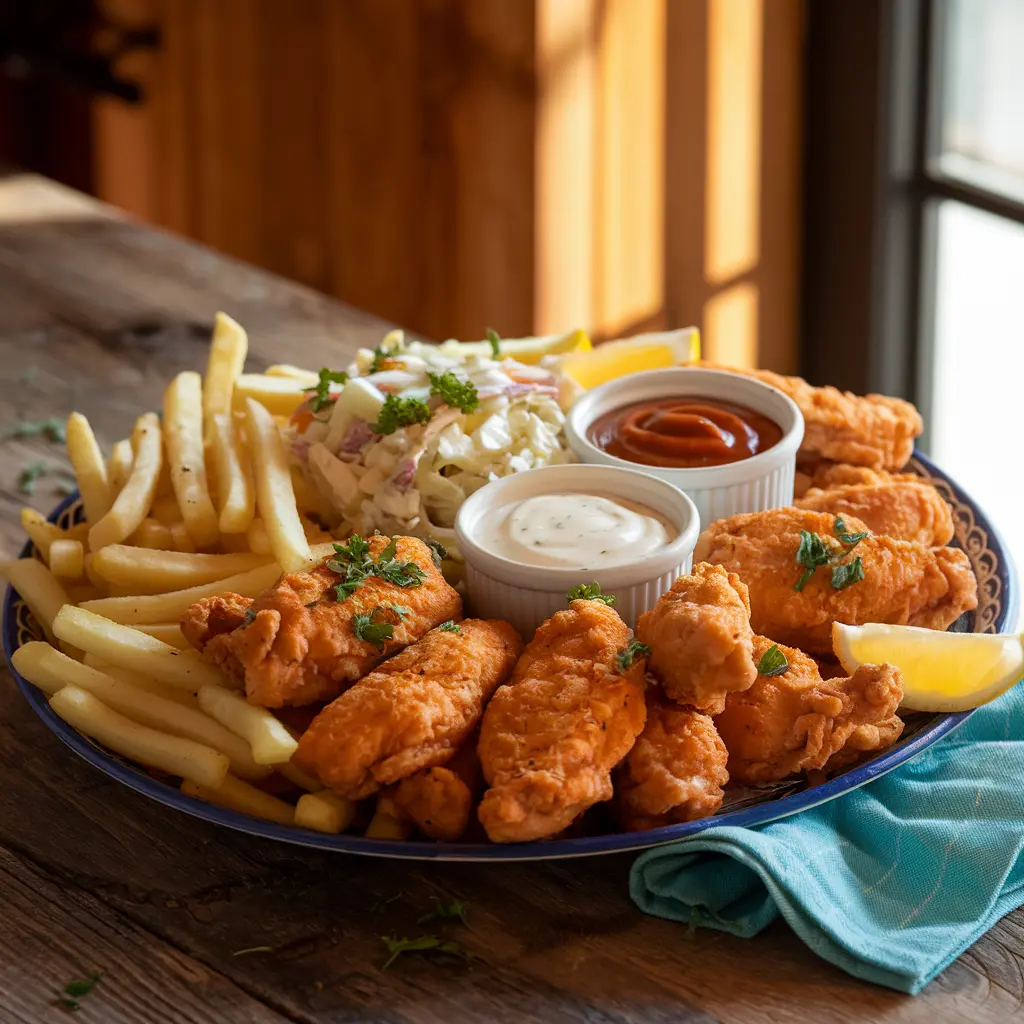
Side Dishes to Complement the Meal
Pairing the tenders with well-matched sides turns this dish into a complete meal:
- French Fries: Crispy fries are a timeless pairing with Buttermilk chicken tenders.
- Coleslaw: The creamy and crunchy slaw balances the richness of the chicken.
- Mashed Potatoes: A comforting and hearty option, especially with gravy on the side.
- Corn on the Cob: Adds a sweet, buttery contrast to the savory tenders.
- Green Salad: A lighter choice that introduces freshness and balance.
- Mac and Cheese: The ultimate comfort food duo for indulgent meals.
Presentation Tips for an Appetizing Plate
- Use a Serving Basket: Serve the tenders in a lined basket for a casual, diner-style presentation.
- Arrange in Layers: Stack tenders slightly for a three-dimensional, mouthwatering appearance.
- Add Garnish: Sprinkle with freshly chopped parsley or green onions for a pop of color.
- Sauces on the Side: Present dipping sauces in ramekins or small bowls to keep the presentation tidy and inviting.
- Include a Lemon Wedge: A squeeze of lemon can brighten the flavors and elevate the dish.
Serving for Different Occasions
- For Kids: Keep it simple with ketchup and fries.
- Game Day Spread: Serve alongside buffalo wings, nachos, and beer for a crowd-pleasing lineup.
- Family Dinner: Add hearty sides like mashed potatoes, coleslaw, and biscuits for a comforting meal.
- Party Appetizer: Cut the tenders into bite-sized pieces and skewer them for easy serving.
FAQs
- Bake Instead of Fry: Baking or air frying reduces oil usage and cuts down on calories. Lightly spray the tenders with cooking oil before baking to maintain a crispy crust.
- Use Whole-Grain Breading: Swap out traditional breadcrumbs for whole-grain options or crushed whole-grain cereal.
- Reduce Salt: Adjust the salt in the marinade and breading for a lower-sodium option.
- Try Greek Yogurt Marinade: Substitute buttermilk with plain Greek yogurt thinned with a little water or lemon juice for similar tenderizing effects and a creamy taste.
Can Buttermilk Chicken Tenders Be Made Healthier?
Yes, there are several ways to make this dish healthier without sacrificing too much flavor or texture:
How Do I Store and Reheat Leftovers?
- Storing: Place leftover chicken tenders in an airtight container and refrigerate for up to 3 days. For longer storage, freeze them in a single layer, then transfer to a freezer-safe bag for up to 3 months.
- Reheating:
- Oven: Reheat tenders at 375°F (190°C) for 10-12 minutes to restore crispiness.
- Air Fryer: Heat for 5-7 minutes at 375°F (190°C) for quick, evenly reheated tenders.
- Microwave: While convenient, this method can result in soggy breading. Use only as a last resort.
Can I Use a Buttermilk Substitute?
Absolutely! Here are a few easy substitutes:
- Milk and Lemon Juice or Vinegar: Add 1 tablespoon of lemon juice or white vinegar to 1 cup of milk and let it sit for 5-10 minutes.
- Plain Yogurt: Thin plain yogurt with water or milk to mimic buttermilk’s consistency.
- Sour Cream: Mix sour cream with a little milk to achieve the right texture.
How Long Should I Marinate the Chicken?
- For optimal results, marinate the chicken for at least 1 hour. This gives the buttermilk time to tenderize the meat.
- For deeper flavor, marinate the chicken overnight (8-12 hours). Avoid marinating for longer than 24 hours, as the acidity can break down the meat too much and alter its texture.
What’s the Best Oil for Frying?
Choose oils with high smoke points for the best results. Some excellent options include:
- Vegetable Oil: Neutral flavor and widely available.
- Canola Oil: A healthier choice with minimal flavor impact.
- Peanut Oil: Adds a subtle nutty flavor and tolerates high heat.
- Sunflower Oil: Another neutral option with a high smoke point.
Can I Make Buttermilk Chicken Tenders Ahead of Time?
Yes! Prepare the tenders up to the breading step and store them in the fridge for up to 1 day before cooking. This is a great option if you’re planning for a party or busy meal prep day.
Conclusion
Buttermilk chicken tenders are a versatile and crowd-pleasing dish that brings together juicy, tender chicken and a satisfyingly crispy coating. By marinating the chicken in buttermilk, you ensure a depth of flavor and tenderness that elevates this dish above standard fried chicken options. Whether you fry, bake, or air fry, the combination of savory seasonings and crunchy breading guarantees a delightful eating experience.
With plenty of options for customization—like healthier cooking methods, unique seasonings, and creative sides—this recipe is perfect for weeknight dinners, family gatherings, or party appetizers. Armed with the tips and techniques shared here, you’re set to create buttermilk chicken tenders that rival your favorite restaurant versions. So, gather your ingredients, roll up your sleeves, and start cooking these irresistible tenders today!

